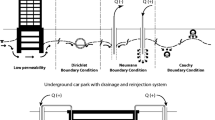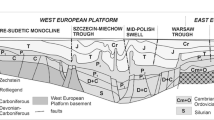Abstract
Underground excavation techniques have become safer, cheaper and faster. Governments of European countries and certain industrial sectors have shown to be prepared to make long-term investments in finding environmentally friendly solutions to resolve infrastructural problems in urban areas resulting from economic growth and increased urbanisation. These two developments have been responsible for a significant increase in European underground infrastructure in the past three decades. An even more spectacular growth can be witnessed in China since 2000. In this paper the use of the subsurface is described against a geological and geotechnical background. In addition, due attention is given to legislation related to underground development. Current legislation in EU countries and beyond is far from adequate to resolve legal issues concerning subsurface structures. In this paper legislation relevant to environmental aspects of subsurface infrastructural elements, and the apparent lack of proper legislative frameworks in this field at national and supra-national (EU) levels, is highlighted. As most indicators point to a more intensive use of the subsurface over the next few decades, geological and legislative constraints will become more and more decisive factors in enabling its optimal use.
Access this chapter
Tax calculation will be finalised at checkout
Purchases are for personal use only
Similar content being viewed by others
References
Aydan Ö, Ohta Y, Geniş M, Tokashiki N, Özbayir K (2010) Response and stability of underground structures in rock mass during earthquakes. Rock Mech Rock Eng 43(6):857–875
Barker MB (1986) Using the earth to save energy: four underground buildings. Tunn Undergr Space Technol 1:59–65
Council of Europe (1992) European convention on the protection of the archaeological heritage (Revised). European treaty series 143. Council of Europe, Strasbourg
Dames and Moore (1983) Use of underground space for storage and disposal. Report for the UK Department of the Environment, London
De Mulder EFJ, Kraas F (2008) Megacities of tomorrow. In: A world of science, 6(4), UNESCO
De Mulder EFJ, Geluk MC, Ritsema I, Westerhoff WE, Wong TE (2003) De ondergrond van Nederland. Geologie van Nederland 7. Nederlands Instituut voor Toegepaste Geowetenschappen TNO (in Dutch)
De Mulder EFJ, Hack HRGK, Van Ree CCDF (2012) Sustainable development and management of the shallow subsurface. Geological Society, London
DINO (2012) DINOLoket. Data en informatie van de Nederlandse ondergrond (DINO). http://www.dinoloket.nl/en/DINOLoket.html
Doyle B (2001) Hazardous gases underground: applications to tunnel engineering (Civil & environmental engineering). CRC Press/Marcel Dekker, Inc., New York
EC (2004) Minimum safety requirements for tunnels in the Trans-European Road Network. European Community Directive 2004/54/EC
EC (2006) Management of waste from extractive industries and amending Directive 2004/35/EC. European Community Directive 2006/21/EC
Ellen GJ, Nijhuis EWJT, Westerhof R, Remmelts G, Werksma H (2002) De rol van de ondergrond in de ruimtelijke ordening, een toekomstverkenning. Report STB-02-25 (in Dutch)
EU (2010) Decision of No 661/2010/EU of the European Parliament and of the Council of 7 July 2010 on Union guidelines for the development of the trans European network (recast). Official Journal of the European Union, L 204/1, 5.8.2010
Fenton GA, Griffiths DV (2008) Risk assessment in geotechnical engineering. Wiley, Hoboken
Hack HRGK, Bremmer CN, Van Deen JK, Van Driel WT, Dreijkoningen GC, Hendriks MAN, Van Kempen MH, Kronieger RR, Kuyntjes JAG, Nobbe JM, Ozmutlu S, Ritsema LL, Rots J, Van der Veer P, Veldkamp H, Verbree E (2000) 3D modellering tweede Heinenoordtunnel; Visualisatie van driedimensionale datasets met behulp van driedimensionale geografische informatie systemen. Centrum Ondergronds Bouwen (CUB); Land Water Milieu Informatietechnologie (LWI); Centrum Uitvoering Research en Regelgeving (CUR), Gouda, p 70 (in Dutch)
ITA (2000) Planning and mapping of underground space – an overview. Working Group No. 4, International Tunnelling Association. Tunn Undergr Space Technol 15:271–296
Lomborg B (2001) The skeptical environmentalist: measuring the real state of the world. Cambridge University Press, Cambridge
Maring L, Wassing B, Kierkaard M (2003) Chances for the subsoil. Paper presented at the first international conference on sustainable development and management of the subsurface. Delft Cluster Utrecht (unpublished)
Marker BR (2003) Out of sight, out of mind? Land use planning and development of the subsurface. Paper presented at the first international conference on sustainable development and management of the subsurface. Delft Cluster Utrecht (unpublished)
Nishida Y, Fabillah H, Ichihara S, Nishi J, Cho KD (2007) The Underground images in Japan, Korea and Indonesia. In: Kaliampakos D, Benardos A (eds) Underground space: expanding the frontiers. Proceedings of the 11th ACUUS international conference, NTUA Press, Athens, Greece, pp 169–174
Ozmutlu S, Hack HRGK (1998) Excavability evaluation and classification with knowledge based GIS. In: Moore DP, Hungr O (eds) Engineering geology, a global view from the Pacific Rim. Proceedings of the 8th congress of the International Association of Engineering Geology and the Environment (IAEG), Vancouver, Canada, pp 591–598
Ozmutlu S, Hack HRGK (2003) 3D modelling system for ground engineering. In: Rosenbaum MS, Turner AK (eds) New paradigms in subsurface prediction; Characterization of the shallow subsurface implications for urban infrastructure and environmental assessment. Lecture notes in earth sciences 99. Springer, Berlin/Heidelberg, pp 253–259
Qian Q, Chen X (2007) Evaluation of the status quo and outlook of the urban underground space Development and utilization in China. In: Kaliampakos D, Benardos A (eds) Underground space: expanding the frontiers. Proceedings of the 11th ACUUS International Conference, NTUA Press, Athens, Greece, pp 15–21
Railway Tunnels (2011) The world’s longest railway tunnels. http://www.lotzberg.net/data/tun10.html
Remmelts G (1997) Gebruiksmogelijkheden van de diepe ondergrond van Nederland. Rapport 97-223-B. Delft. Nederlands Instituut voor Toegepaste Geowetenschappen TNO, Utrecht, The Netherlands (in Dutch)
Road Tunnels (2011) The world’s longest road tunnels. http://www.lotzberg.net/data/rail.html
Rogers S, Horseman S (1999) Underground space – the final frontier? Earthwise, 13/11. British Geological Survey, Keyworth, UK, 1999
Salminen R (ed), Batista MJ, Bidovec M, Demetriades A, De Vivo B, De Vos W, Duris M, Gilucis A, Gregorauskiene V, Halamic J, Heitzmann P, Lima A, Jordan G, Klaver G, Klein P, Lis J, Locutura J, Marsina K, Mazreku A, O’Connor PJ, Olsson SÅ, Ottesen RT, Petersell V, Plant JA, Reeder S, Salpeteur I, Sandström H, Siewers U, Steenfelt A, Tarvainen T (2005) Geochemical Atlas of Europe. Geological Survey of Finland
Shin H-S, Park ES (2007) The current status of underground space utilization in Korea. In: Kaliampakos D, Benardos A (eds) Underground space: expanding the frontiers. Proceedings of the 11th ACUUS International Conference, NTUA Press, Athens, Greece, pp 181–186
Stoter JE, van Oosterom PJM, Ploeger HD, Aalders HJ (2004) Conceptual 3D Cadastral Model applied in several countries. FIG Working Week, The Netherlands
Tunnel Canada (2011) Tunnelling Association of Canada. http://www.tunnelcanada.ca
United Nations Population Division (2011) World population prospects: the 2010 revision, highlights and advance tables. Working paper no. ESA/P/WP.220. Population Division, Department of Economic and Social Affairs, United Nations, New York
United Nations Population Division (2012) World urbanization prospects: the 2010 revision: highlights. Working paper no. ESA/P/WP.224. Population Division, Department of Economic and Social Affairs, United Nations, New York
Wang ZZ, Gao B, Jiang Y, Yuan S (2009) Investigation and assessment on mountain tunnels and geotechnical damage after the Wenchuan earthquake. Sci China Ser E Technol Sci 522:546–558
Yu M, Wang H, Ni D (2009) Underground space development of Expo Axis of Shanghai Expo Park. In: Proceedings of the 12th international conference ACUUS, Beijing, pp 110–114
Author information
Authors and Affiliations
Corresponding author
Editor information
Editors and Affiliations
Rights and permissions
Copyright information
© 2015 Springer Science+Business Media Dordrecht
About this paper
Cite this paper
de Mulder, E.F.J., van Ree, C.C.D.F., Hack, H.R.G.K. (2015). Geo-environmental Aspects of European Underground Infrastructure. In: Culshaw, M., Osipov, V., Booth, S., Victorov, A. (eds) Environmental Security of the European Cross-Border Energy Supply Infrastructure. NATO Science for Peace and Security Series C: Environmental Security. Springer, Dordrecht. https://doi.org/10.1007/978-94-017-9538-8_9
Download citation
DOI: https://doi.org/10.1007/978-94-017-9538-8_9
Published:
Publisher Name: Springer, Dordrecht
Print ISBN: 978-94-017-9537-1
Online ISBN: 978-94-017-9538-8
eBook Packages: Earth and Environmental ScienceEarth and Environmental Science (R0)




